MA Thesis Project
Thesis project focused on designing for families of newly diagnosed
diabetic children.
Read time: 10 mins
For my MA Interaction Design thesis project I chose to look at designing for diabetics, mostly focusing on data recording and the interpretation of this data. The first step of my project would be to set my project brief which was as follows –
It is estimated that there are close to 200,000 people in Ireland today living with Type 1 or Type 2 diabetes. With these numbers expected to surpass 300,000 by 2030 it is clear that diabetes is a huge issue in our society.
In this project I will explore how sufferers deal with their diabetes looking at everything from where, when and how they check their blood glucose levels to how it effects their lives and the lives of those around them. I will look mostly at how these people collect data on their blood glucose levels and then look at how they interoperate this data and how they make use of this data in their day to day lives.
For this project I will focus on users who independently look after their own diabetes (approx 18-75) while also gaining insights from their support groups in the form of families, friends and healthcare professionals. By talking to these people I hope to gain an insight into the types of glucose monitors used, the frequency of use, the location of use, the interpretation and recording of data and how the users make this data work for them in their day to day lives.
For my MA Interaction Design thesis project I chose to look at designing for diabetics, mostly focusing on data recording and the interpretation of this data. The first step of my project would be to set my project brief which was as follows –
It is estimated that there are close to 200,000 people in Ireland today living with Type 1 or Type 2 diabetes. With these numbers expected to surpass 300,000 by 2030 it is clear that diabetes is a huge issue in our society.
In this project I will explore how sufferers deal with their diabetes looking at everything from where, when and how they check their blood glucose levels to how it effects their lives and the lives of those around them. I will look mostly at how these people collect data on their blood glucose levels and then look at how they interoperate this data and how they make use of this data in their day to day lives.
For this project I will focus on users who independently look after their own diabetes (approx 18-75) while also gaining insights from their support groups in the form of families, friends and healthcare professionals. By talking to these people I hope to gain an insight into the types of glucose monitors used, the frequency of use, the location of use, the interpretation and recording of data and how the users make this data work for them in their day to day lives.
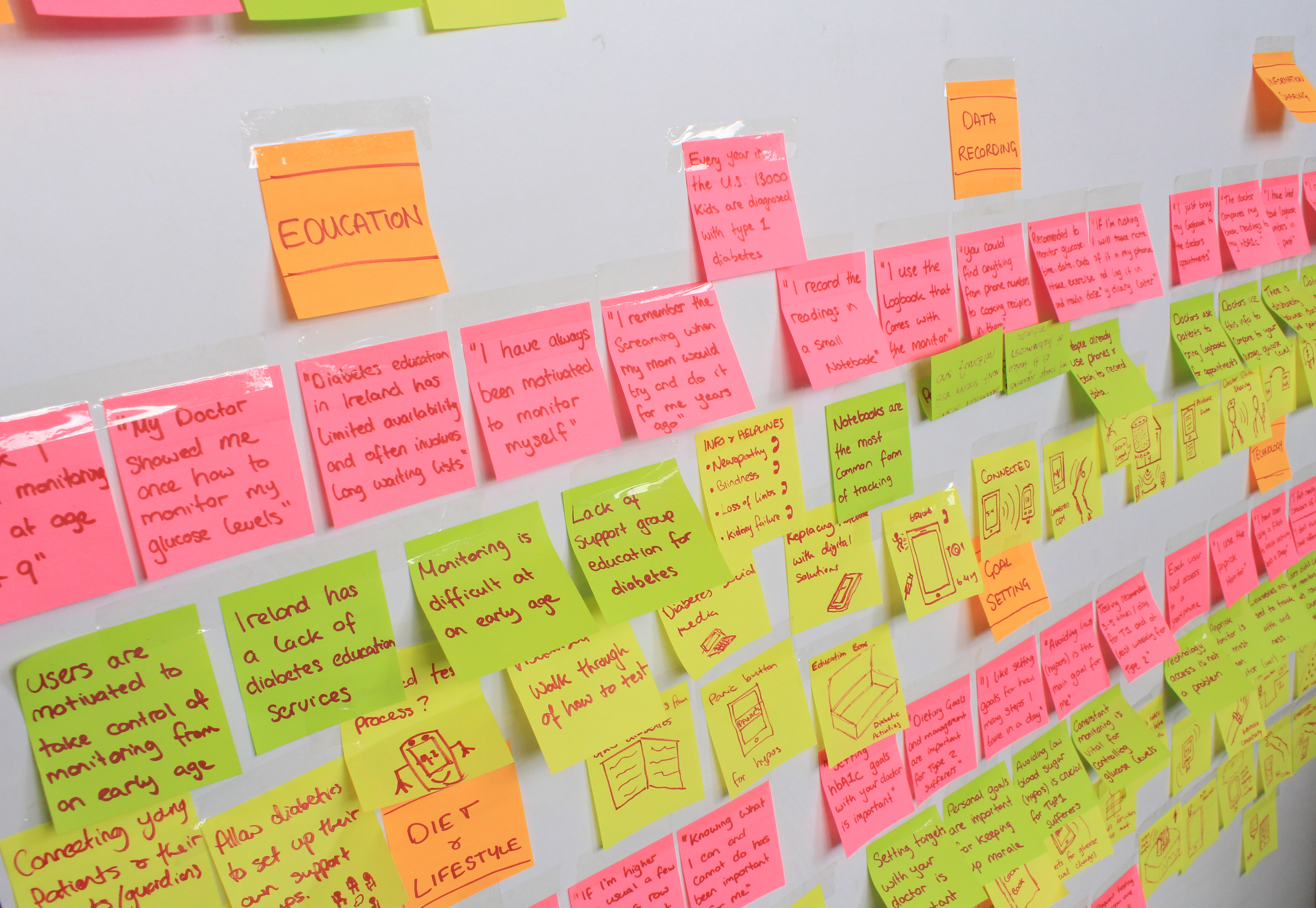
My initial Secondary Research for this project was based around trying to find out as much as I possibly could about diabetes and its effect on diabetes sufferers lives. I felt that this was an extremely important step as when I was going on to conduct interviews with diabetes sufferers it was important that I had enough knowledge so that I could hold a meaningful conversation.
As well as secondary research into diabetes, I also attended a CODE Diabetes Education class in Naas. This class was focused on type 2 diabetic care and gave me really good insights into the glucose monitoring process and also the self management needed to control diabetes.
In total I conducted interviews with 6 diabetes sufferers and some family members close to them in order to try and gain an understanding into what it is like living with diabetes and also to try and gain insights into what kind of monitors and processes they used to measure their blood glucose levels and control their diabetes.
During this stage of the project I also bought a glucose monitor that I tested myself with 6 times a day (Average amount of daily tests from interviews) for a week. By doing this I wanted to get a first hand idea of much care is needed to manage diabetes and I also wanted to get explore the situational context when monitoring (One user explained how at work she would always monitor herself in the bathroom).
As well as secondary research into diabetes, I also attended a CODE Diabetes Education class in Naas. This class was focused on type 2 diabetic care and gave me really good insights into the glucose monitoring process and also the self management needed to control diabetes.
In total I conducted interviews with 6 diabetes sufferers and some family members close to them in order to try and gain an understanding into what it is like living with diabetes and also to try and gain insights into what kind of monitors and processes they used to measure their blood glucose levels and control their diabetes.
During this stage of the project I also bought a glucose monitor that I tested myself with 6 times a day (Average amount of daily tests from interviews) for a week. By doing this I wanted to get a first hand idea of much care is needed to manage diabetes and I also wanted to get explore the situational context when monitoring (One user explained how at work she would always monitor herself in the bathroom).
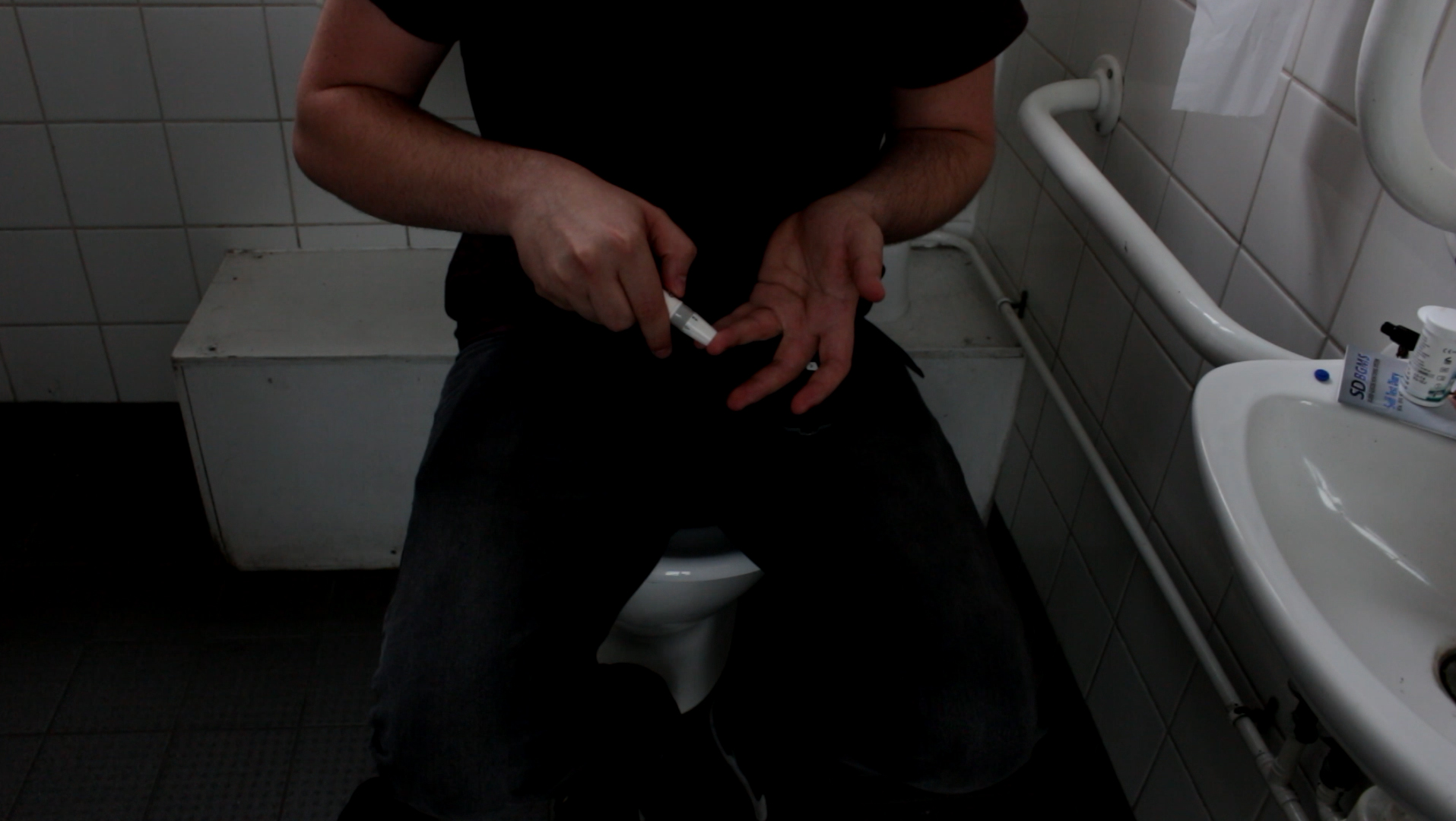
The next step was to go through each of the participant boards and try and correlate some common themes that came up during the interviews. This was done by colour coding individual post-it notes in order to sort them into their specific themes. When this was done the post-it notes were rearranged and grouped into their specific themes in an Affinity Diagram. The main themes generated were Education, Data Recording, Information Sharing, Diet and Lifestyle, Goal Setting, Technology and Routine Setting.
The affinity diagram was made using different coloured post it notes for different headings so it was as easy to read as possible. It was arranged so that orange was the theme, pink was the learning or direct quote from the interviews, green were the insights taken from these learnings and yellow were the opportunities or initial concepts that I had.
The three themes I chose to take forward for my three concepts for the concept stage of my project were Education, Data Recording and Diet and Lifestyle. The themes of data recording and diet and lifestyle were ones that I had earmarked as possible project directions at the start of my project and Education was one that kept on popping up during my research. It was not an option that I had seriously considered until our industry concept review when I presented my rough concept for an education kit that would be used by parents of newly diagnosed diabetic children.
The affinity diagram was made using different coloured post it notes for different headings so it was as easy to read as possible. It was arranged so that orange was the theme, pink was the learning or direct quote from the interviews, green were the insights taken from these learnings and yellow were the opportunities or initial concepts that I had.
The three themes I chose to take forward for my three concepts for the concept stage of my project were Education, Data Recording and Diet and Lifestyle. The themes of data recording and diet and lifestyle were ones that I had earmarked as possible project directions at the start of my project and Education was one that kept on popping up during my research. It was not an option that I had seriously considered until our industry concept review when I presented my rough concept for an education kit that would be used by parents of newly diagnosed diabetic children.
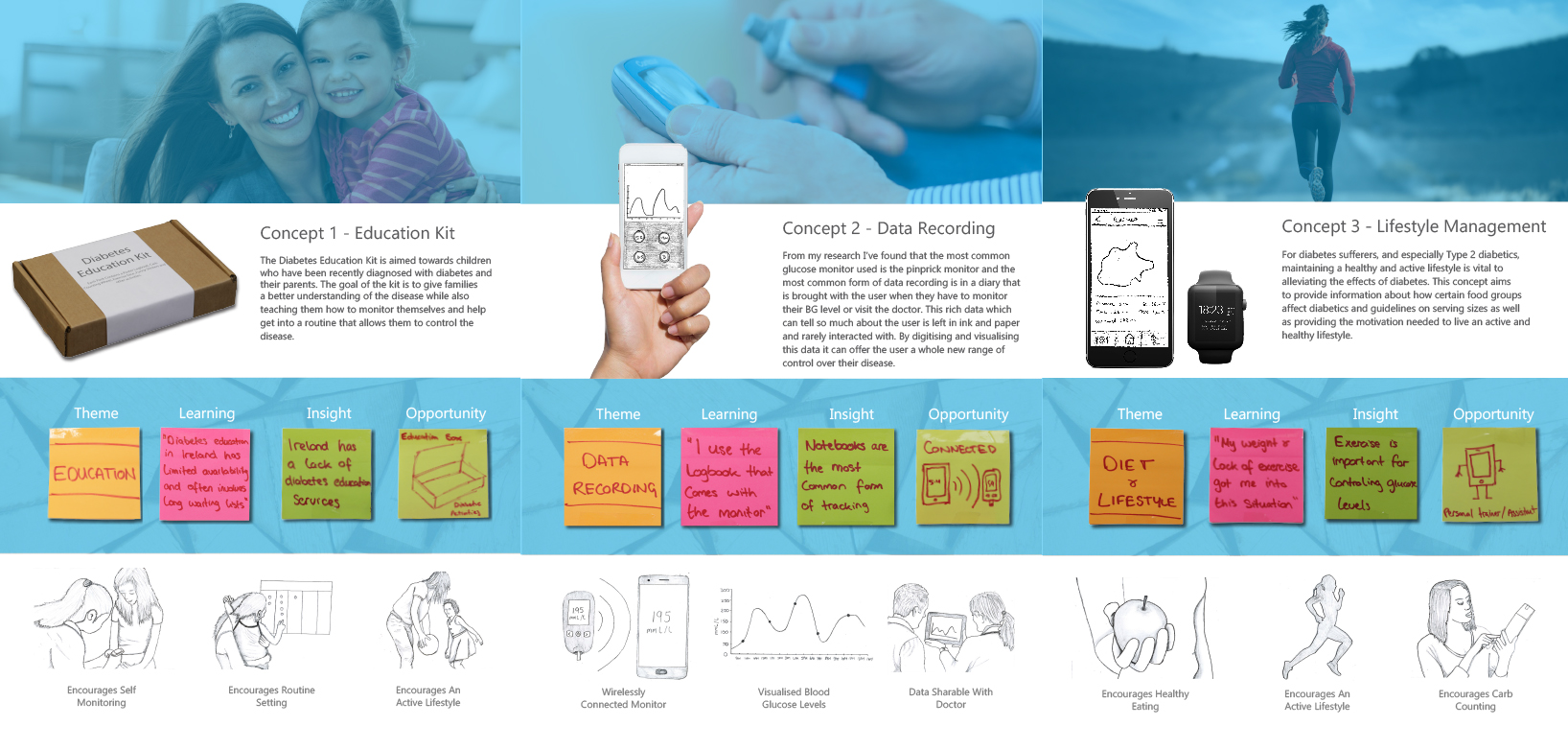
After the concept reviews I decided that I would go forward looking at diabetes education for parents of newly diagnosed diabetic children. the concept I chose to bring forward consisted of a diabetes education kit that would have information for the parents about diabetes and also some playful components that the children and parents could interact with. Because my project was completely changing direction from my initial brief it was important that I remodel my design brief and carry out some more research with my new focus area in mind.
It is estimated that there are close to 200,000 people in Ireland today living with Type 1 or Type 2 diabetes. With these numbers expected to surpass 300,000 by 2030 it is clear that diabetes is a huge issue in our society
In this project I will explore how parents and children who are recently diagnosed learn about diabetes and everything it entails. I will look at educating parents and children through playful interactions in the hope that it will alleviate some of the intial fears thay have and help them to get into a routine that works for them.
As well as education I will also try to encourage a healthy and active lifestyle through carb counting tips and fun physical activities.
After some searching I came into contact with two families with children who have recently been diagnosed with type 1 diabetes. It was important for me that I talk with these families to better understand their initial fears and concerns when their child was diagnosed with diabetes. These interviews I carried out were extremely useful and I go some really good insights into different “life hack’s” that these families use to help calm their child when they are monitoring blood glucose levels or dosing insulin. A lot of the final components in the kit were created directly from the life hacks explained to me by these families. These families would also be vital for testing further down the line.
It is estimated that there are close to 200,000 people in Ireland today living with Type 1 or Type 2 diabetes. With these numbers expected to surpass 300,000 by 2030 it is clear that diabetes is a huge issue in our society
In this project I will explore how parents and children who are recently diagnosed learn about diabetes and everything it entails. I will look at educating parents and children through playful interactions in the hope that it will alleviate some of the intial fears thay have and help them to get into a routine that works for them.
As well as education I will also try to encourage a healthy and active lifestyle through carb counting tips and fun physical activities.
After some searching I came into contact with two families with children who have recently been diagnosed with type 1 diabetes. It was important for me that I talk with these families to better understand their initial fears and concerns when their child was diagnosed with diabetes. These interviews I carried out were extremely useful and I go some really good insights into different “life hack’s” that these families use to help calm their child when they are monitoring blood glucose levels or dosing insulin. A lot of the final components in the kit were created directly from the life hacks explained to me by these families. These families would also be vital for testing further down the line.
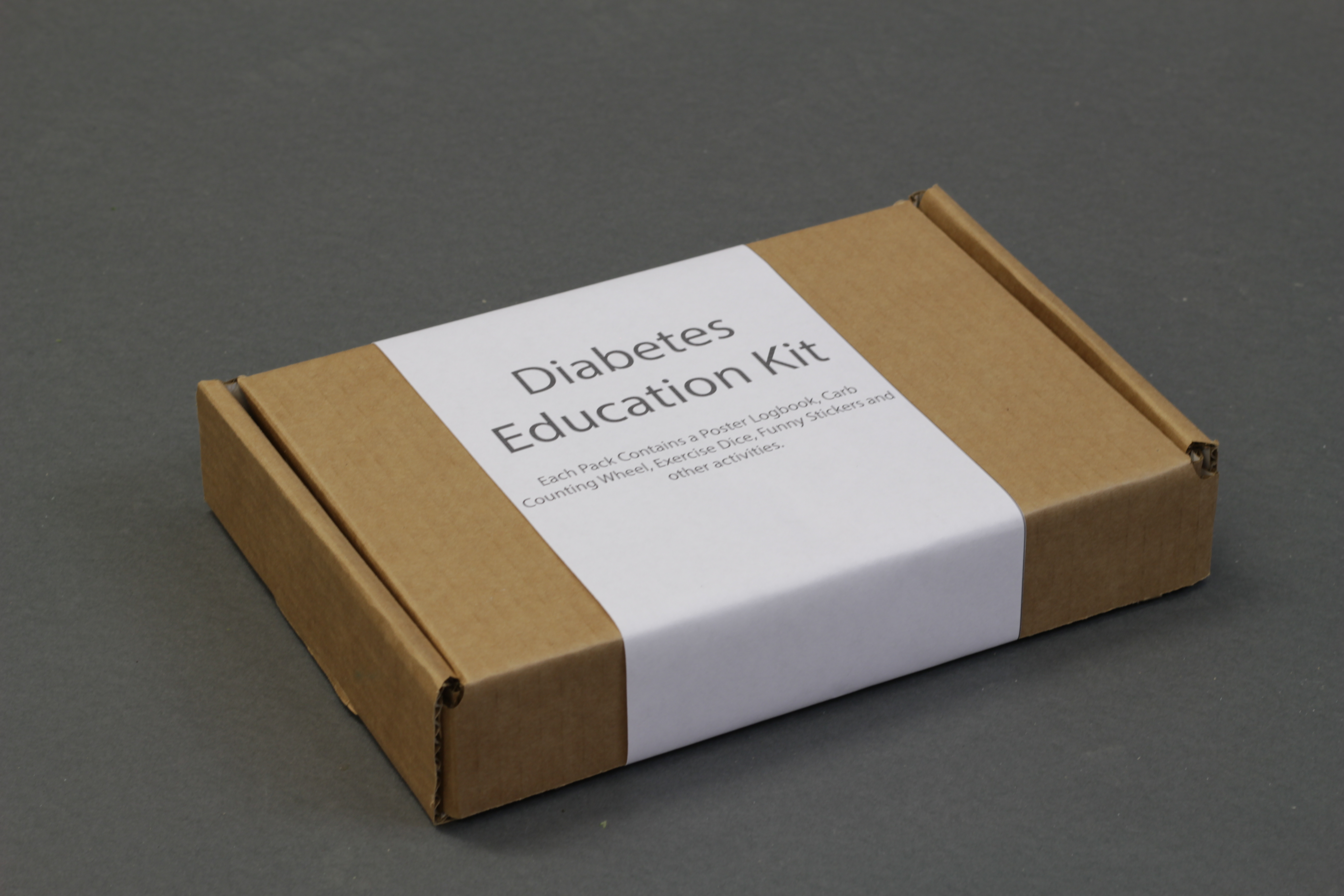
Glucosnap Concept
The final design solution for this project consisted of a diabetes education kit and an accompanying app for logging blood glucose levels. The main aims of the education kit are to build confidence for the parents, to help to alleviate some of the initial fears that they might have and to aid with routine setting. It does this by providing go-to information that is easy to understand and can be kept close to hand. The app component is used for logging blood glucose, carb intake and insulin intake. This information is recorded by the child through photo logging and can be accessed remotely by the parents. This gives the parents a feeling of control even when they are not present with their child.
Final Kit Components
After discussing my ideas for the contents of the kit with my tutors and with the families that I had interviewed it was time to narrow it down to its final components.
• 3 x Monitoring Reward Books
• 1 x Equipment Set Up Guide
• 1 x Emergency Response Guide
• 1 x Carb Counting Wheel
• 1 x Numbing Freezer Pad
• 1 x Assorted Sticker Set
The final design solution for this project consisted of a diabetes education kit and an accompanying app for logging blood glucose levels. The main aims of the education kit are to build confidence for the parents, to help to alleviate some of the initial fears that they might have and to aid with routine setting. It does this by providing go-to information that is easy to understand and can be kept close to hand. The app component is used for logging blood glucose, carb intake and insulin intake. This information is recorded by the child through photo logging and can be accessed remotely by the parents. This gives the parents a feeling of control even when they are not present with their child.
Final Kit Components
After discussing my ideas for the contents of the kit with my tutors and with the families that I had interviewed it was time to narrow it down to its final components.
• 3 x Monitoring Reward Books
• 1 x Equipment Set Up Guide
• 1 x Emergency Response Guide
• 1 x Carb Counting Wheel
• 1 x Numbing Freezer Pad
• 1 x Assorted Sticker Set
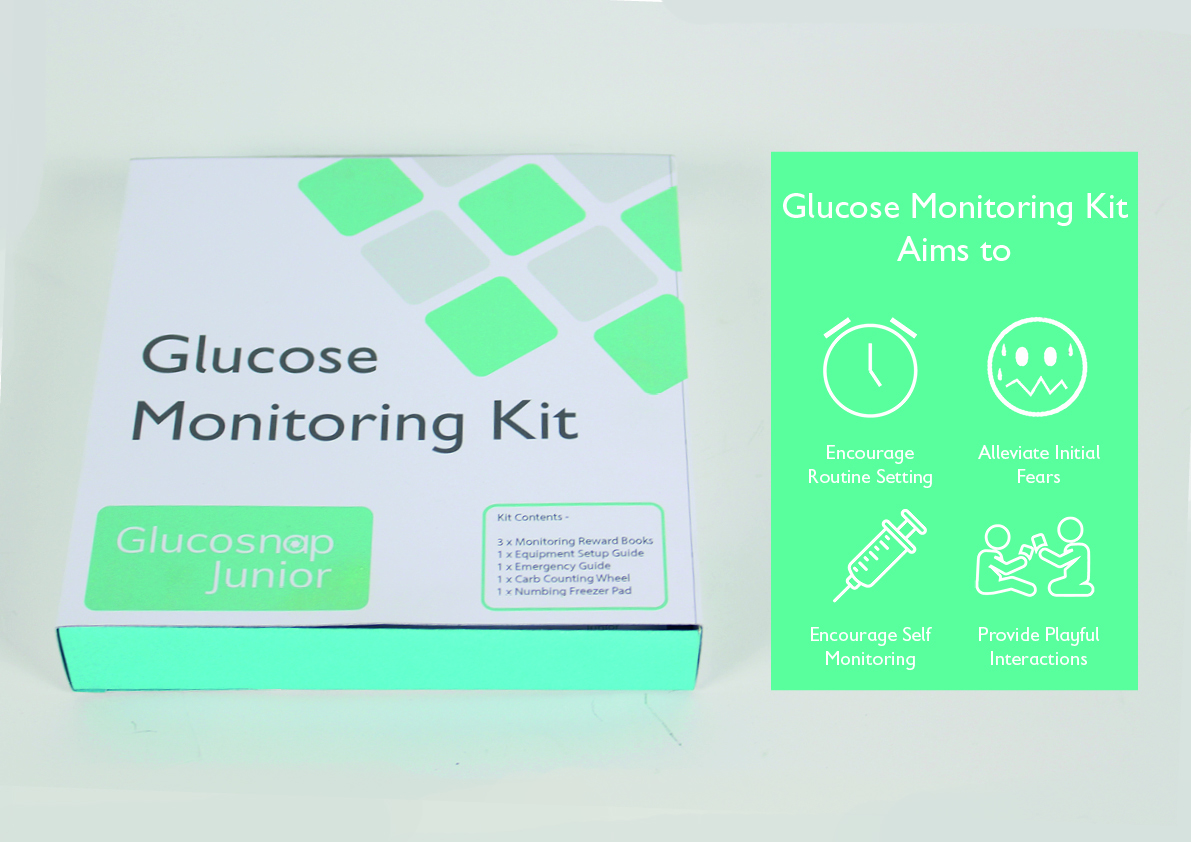
Final App Features
Before starting into wire-framing and creating a site map for the app that would accompany the monitoring kit it was important that I knew what I wanted the app to do for both the parent and the child. The easiest way to do this was to list out all of the features that I felt the app should have and then run this by some of the potential users to get an idea of what would work and what would be deemed unnecessary. This activity was carried out through a kind of card sort where I asked potential users to rank the features of the app by what they think they would find most useful to least.
Because there is two different sides to the proposed app, the parent’s side and the child’s side, it was important that I had a feature list for both as both potential users have very different needs. Some of the child’s portal features include
• Customisable digital avatar.
• Blood Glucose, carb and insulin data recording.
• Photo data recording.
• In app messaging.
The child’s side of the app needs to be light and playful while also being able to record important data easily.
The parent’s side of the app is more focused on data presentation and should be done so through a very clean and simple interface that doesn’t require a lot of interaction to update and edit the data that is being recorded by their child. Some of the features include
• Monitoring dashboard
• Ability to edit data
• Target goal setting
• HbA1c estimates
• Sharable data
Before starting into wire-framing and creating a site map for the app that would accompany the monitoring kit it was important that I knew what I wanted the app to do for both the parent and the child. The easiest way to do this was to list out all of the features that I felt the app should have and then run this by some of the potential users to get an idea of what would work and what would be deemed unnecessary. This activity was carried out through a kind of card sort where I asked potential users to rank the features of the app by what they think they would find most useful to least.
Because there is two different sides to the proposed app, the parent’s side and the child’s side, it was important that I had a feature list for both as both potential users have very different needs. Some of the child’s portal features include
• Customisable digital avatar.
• Blood Glucose, carb and insulin data recording.
• Photo data recording.
• In app messaging.
The child’s side of the app needs to be light and playful while also being able to record important data easily.
The parent’s side of the app is more focused on data presentation and should be done so through a very clean and simple interface that doesn’t require a lot of interaction to update and edit the data that is being recorded by their child. Some of the features include
• Monitoring dashboard
• Ability to edit data
• Target goal setting
• HbA1c estimates
• Sharable data
Glucosnap_Final_Video from Shane Scally on Vimeo.